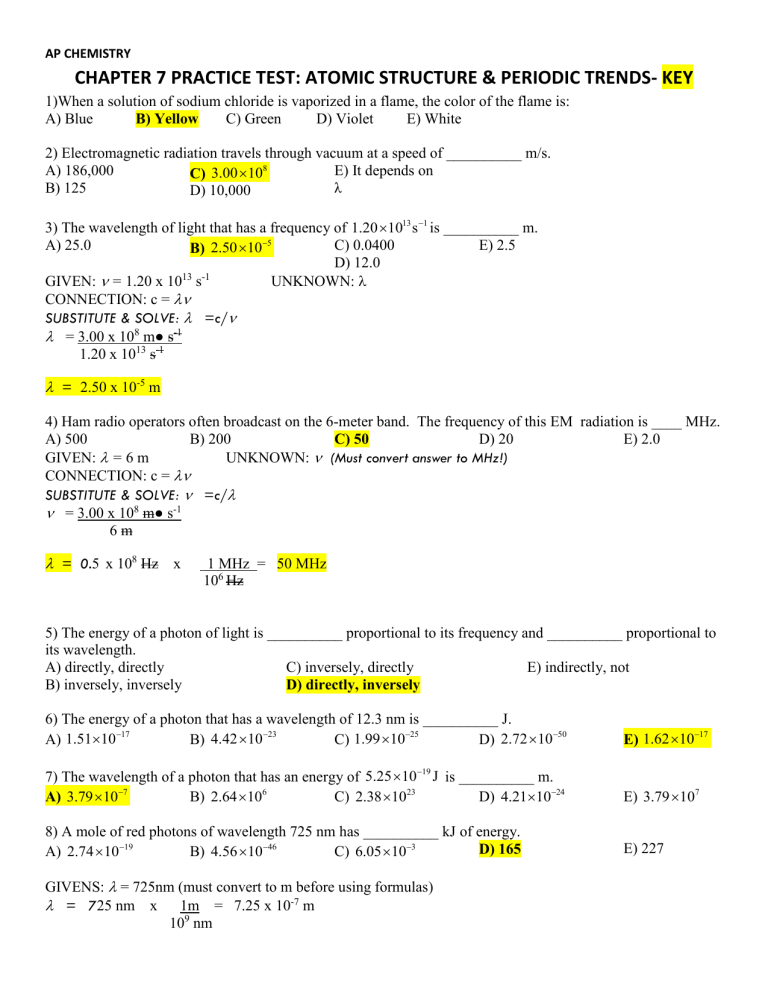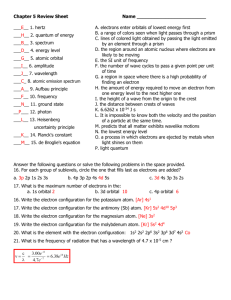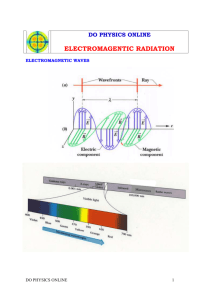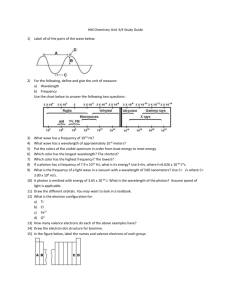AP CHEMISTRY CHAPTER 7 PRACTICE TEST: ATOMIC

AP CHEMISTRY
CHAPTER 7 PRACTICE TEST: ATOMIC STRUCTURE & PERIODIC TRENDS- KEY
1)When a solution of sodium chloride is vaporized in a flame, the color of the flame is:
A) Blue B) Yellow C) Green D) Violet E) White
2) Electromagnetic radiation travels through vacuum at a speed of __________ m/s.
A) 186,000
B) 125
C)
8
D) 10,000
E) It depends on
λ
3) The wavelength of light that has a frequency of
A) 25.0 B)
5 C) 0.0400
D) 12.0
UNKNOWN:
GIVEN:
= 1.20 x 10
13
s
-1
CONNECTION: c =
SUBSTITUTE & SOLVE: =c/
= 3.00 x 10
8
m● s
-1
13
1
1.20 x 10
13
s
-1 is __________ m.
E) 2.5
=
2.50 x 10
-5
m
4) Ham radio operators often broadcast on the 6-meter band. The frequency of this EM radiation is ____ MHz.
A) 500
GIVEN:
= 6 m
CONNECTION: c =
SUBSTITUTE & SOLVE: =c/
= 3.00 x 10 8 m● s -1
B) 200 C) 50 D) 20
UNKNOWN:
(Must convert answer to MHz!)
E) 2.0
6 m
= 0.
5 x 10 8 Hz x 1 MHz = 50 MHz
10
6
Hz
5) The energy of a photon of light is __________ proportional to its frequency and __________ proportional to its wavelength.
A) directly, directly
B) inversely, inversely
C) inversely, directly
D) directly, inversely
E) indirectly, not
6) The energy of a photon that has a wavelength of 12.3 nm is __________ J.
A)
17
B)
23
C)
25
D)
7) The wavelength of a photon that has an energy of
A)
7
B)
6
C)
5.25 10
19 J
23
D)
50
is __________ m.
24
8) A mole of red photons of wavelength 725 nm has __________ kJ of energy.
A)
19
B)
46
C)
3 D) 165
GIVENS:
= 725nm (must convert to m before using formulas)
= 7 25 nm x 1m = 7.25 x 10
-7
m
10
9
nm
E)
E)
E) 227
17
7
UNKNOWN: E (in kJ. Must convert answer from J to kJ/mol)
CONNECTION: Use c =
AND E = h
to derive 1 formula (or do it in 2 steps). I will derive.
Isolate
in the first equation to get
= c/
.
Substitute this value for
into the second equation to get: E = hc. This equation is used a lot.
Now Substitute known values for h, c, and
to solve for E.
E = (6.63 X 10
-34
J●s)(3.00 x 10
8 m●s
-1
)
7.25 x 10
-7
m
E = 2.74 x 10
–19
J x 1kJ x 6.02 x 10 23 photons
1 photon 10
3
J 1 mole photons
E = 1.65 x 10
2
kJ/mole photons
(convert to kJ/mol)
9) It takes 254 kJ/mol to eject electrons from a certain metal surface. What is the longest wavelength of light
(nm) that can be used to eject electrons from the surface of this metal via the photoelectric effect?
A) 471 B) 233 C) 165 D) 725 E) 552
GIVEN: 254 kJ/mol (must first be converted to J)
254 kJ x 10
3
J x 1 mol electrons
1 mol electrons 1kJ 6.02 x 10
23
electrons
UNKNOWN:
= 4.22 x 10
-19
J (Convert kJ/mol
J)
= hc/E (this equation is the same as the derived equation in Free Response #1bii.)
SUBSTITUTE KNOWN VALUES & SOLVE:
= = (6.63 X 10
-34
J●s)(3.00 x 10
8 m●s
-1
)
4.22 x 10 -19 J
= 4.71 x 10 -7 m
10) Of the following, __________ radiation has the longest wavelength and __________ radiation has the greatest energy. infrared ultraviolet visible
A) ultraviolet, infrared
B) visible, ultraviolet
C) infrared, infrared
D) visible, infrared
E) infrared, ultraviolet
11) Of the following transitions in the Bohr hydrogen atom, the __________ transition results in the emission of the highest-energy photon.
A) n = 1 → n = 6
B) n = 6 → n = 1
C) n = 6 → n = 3
D) n = 3 → n = 6
E) n = 1 → n = 4
12) Using Bohr's equation for the energy levels of the electron in the hydrogen atom, determine the energy (J) of an electron in the n = 4 level.
A)
B)
1.36 10
19
5.45 10
19
C)
D)
18
1.84 10
29
E)
1.84 10
29
GIVENS: n = 4 UNKNOWN: E = ?J
CONNECTION: E n
= -2.178 x 10 -18 J n
2
(This formula is on the AP Exam Formula Sheet and calculates the energy of an electron in the n energy level.)
SUBSTITUTE & SOLVE
E n
= -2.178 x 10
-18
J
n
2
E n
= -2.178 x 10
-18
J
4
2
E n
= -1.36 x 10
-19
J
13) A spectrum containing only specific wavelengths is called a __________ spectrum.
A) line B) continuous C) visible
14) The deBroglie wavelength of a particle is given by __________.
D) Rydberg
A) h + mv
E) mv
B) hmv C) h/mv D) mv/c
15) The __________ quantum number defines the shape of an orbital.
A) spin B) magnetic C) principal D) angular
E) invariant
E) photon
16) The principal quantum number of the first d subshell is __________.
A) 1 B) 2 C) 3 D) 4
17) How many p-orbitals are occupied in a Ne atom?
A) 5 B) 6 C) 1 D) 3
E) 0
E) 2
18) How many quantum numbers are necessary to designate a particular electron in an atom?
A) 3 B) 4 C) 2 D) 1 E) 5
19) There are __________ unpaired electrons in a ground state phosphorus atom.
A) 0 B) 1 C) 2 D) 3 E) 4
20) The elements in the __________ period of the periodic table have a core-electron configuration that is the same as the electron configuration of neon.
A) first B) second C) third
21) The uncertainty principle states that __________.
A) matter and energy are really the same thing
B) it is impossible to know anything with certainty
D) fourth
C) it is impossible to know the exact position and momentum of an electron
D) there can only be one uncertain digit in a reported number
E) it is impossible to know how many electrons there are in an atom
E) fifth
22) An electron cannot have the quantum numbers n = __________, l = __________, m l = __________.
A) 2, 0, 0 B) 2, 1, -1 C) 3, 1, -1
E) n only
D) 1, 1, 1 E) 3, 2, 1
23) Which one of the following configurations depicts an excited oxygen atom?
A)
2 2 2
1s 2s 2p C)
2 2 1
1s 2s 2p E)
2 4
B)
2 2 2 2
1s 2s 2p 3s D)
2 2 4
1s 2s 2p
24) Which electron configuration represents a violation of Hund's rule for an atom in its ground state?
A)
C)
B) D)
E)
Section II
(Total Time – 20 minutes)
Part A: YOU MAY USE YOUR CALCULATOR FOR PART A
CLEARLY SHOW THE METHOD USED AND THE STEPS INVOLVED IN ARRIVING AT YOUR
ANSWERS. It is to your advantage to do this, since you may obtain partial credit if you do and you will receive little or no credit if you do not. Attention should be paid to significant figures.
Be sure to write all your answers to the questions on the lined pages following each question in the booklet with the pink cover. Do NOT write your answers on the green insert.
1.
Answer the following questions regarding light and its interactions with molecules, atoms, and ions.
(a) The longest wavelength of light with enough energy to break the Cl-Cl bond in Cl2(g) is 495 nm.
(i) calculate the frequency, in s-1, of the light.
(ii) Calculate the energy, in J, of a photon of the light.
(iii)Calculate the minimum energy, in kJ mol-1 of the Cl-Cl bond.
(b) A certain line in the spectrum of atomic hydrogen is associated with the electronic transition in the H atom from the sixth energy level (n=6) to the second energy level (n=2).
(i) Indicate whether the H atom emits energy or absorbs energy during the transition. Justify your answer.
(ii) Calculate the wavelength, in nm, of the radiation associated with the same electronic transition (n=6 to n=2) in the He+ ion is greater than that associated with the corresponding transition in the H atom.
1 a i) GIVEN: λ = 495 nm (must convert to m) UNKNOWN: frequency,
=?in s-1
c = 3.00 x 10 8 m/s NOTE: s-1 = wps = Hz
CONNECTION: Use c =
Convert 495 nm to m. 495 nm x 1 m = 4.95 x 10 -7 m= λ
10 9 nm
Substitute known values and solve for unknown ( )
3.00 x 10 8 m/s = (4.95 x 10 -7 m)
3.00 x 10 8 m/s = (4.95 x 10 -7 m)
(4.95 x 10 -7 m) (4.95 x 10 -7 m)
6.06 x 10 14 s -1 =
a ii) GIVENS: See above values for & UNKNOWN: E = ? in J (of a photon)
CONNECTION: E = h
Substitute known values and solve for unknown (E)
E = (6.63 x 10 -34 J ● s) (6.06 x 10 14 s -1 )
E= 4.02 x 10 -19 J a iii)GIVENS: See above values for UNKNOWN: E =? in kJ ● mol -1
E = 4.02 x 10 -19 J x 1kJ x 6.02 x 10 23 electrons = 2.42 x 10 2 kJ/mol electrons
(1 electron) 10 3 J 1 mole electrons b i) The H atom emits energy as the electron falls from the 6 th energy level to the 2 nd . The energy of the electron at n
= 6 is higher than when it is at n = 2. Therefore, energy is emitted, or lost, as the electron transitions closer to the nucleus. It does this in the form of electromagnetic radiation that is equal in energy to the difference between the electron energy at n=6 and n = 2. b ii) GIVENS: n i
= 2 UNKNOWN: (in nm, so you will have to convert your answer)
n f
= 6
CONNECTION: This one is a little tricky.
You must use the equation ∆E = -R
H
(1/n f2
– 1/n i2
) to solve for E, so you can then plug the E value into = hc/E to solve for wavelength.
OR you can do it in 2 steps, or “merge” the two equations to derive the one you need: = hc
-R
H
(1/n f2
– 1/n i2
)
I will solve using the second method, which involved the one derived (“merged”) equation
SUBSTITUTE KNOWN VALUES & SOLVE FOR
= (6.63 X 10 -34 J ● s)(3.00 x 10 8 m ● s -1 )
(-2.178 x 10 -18 J)(1/2 2 – 1/6 2 )
= 19.89 x 10 -26 m
0.484 x 10 -18
= 4.11 x 10 -7 m x 10 9 nm = 4.11 x 10 2 nm
1 m








